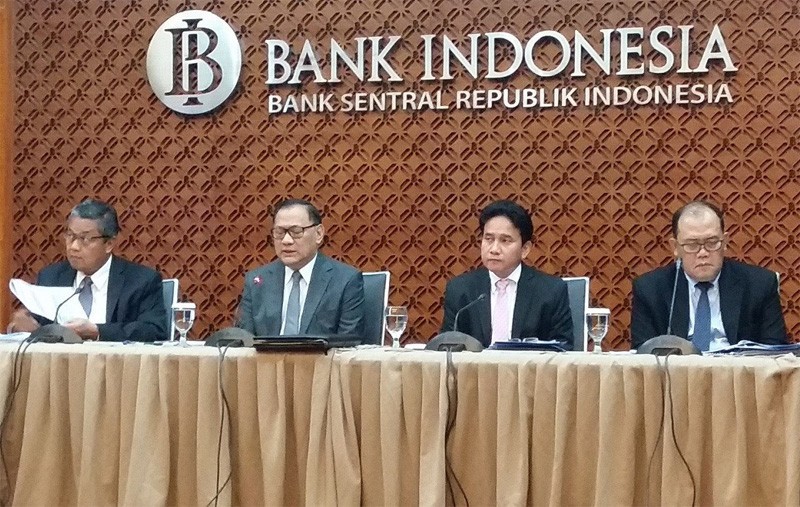Bank Indonesia to gradually implement new rule on banks’ minimum reserve
Change Size
 Guardians of monetary policy: Bank Indonesia deputy governor Perry Warjiyo (left), governor Agus Martowardojo (second left), senior deputy governor Mirza Adityaswara (second right) and deputy governor Hendar speak at a press conference at the central bank office in Jakarta on Nov. 17. (JP/Anton Hermansyah)
Guardians of monetary policy: Bank Indonesia deputy governor Perry Warjiyo (left), governor Agus Martowardojo (second left), senior deputy governor Mirza Adityaswara (second right) and deputy governor Hendar speak at a press conference at the central bank office in Jakarta on Nov. 17. (JP/Anton Hermansyah)
B
ank Indonesia (BI) plans to partially implement a new policy on the minimum funds that banks need to hold in reserve at the central bank, as it seeks to give banks more space for liquid assets that could eventually boost lending.
BI recently announced it would change the way it required banks to store their primary reserve requirement (GWM) — the minimum funds banks store as a reserve at the central bank — from currently setting aside 6.5 percent of third party funds by the end of each day.
From the second half of 2017, the central bank will relax the GWM requirement as long as banks meet a certain average percentage within two weeks. BI has yet to disclose the policy in great detail, although senior deputy governor Mirza Adityaswara said it would give banks time to adapt.
“For instance, only 1.5 percent will follow the new averaging policy, while the remaining 5 percent will still follow the conventional GWM policy,” BI senior deputy governor Mirza Adityaswara said on Thursday.
Therefore, banks should maintain 5 percent of their third party funds by the end of each day, while the other 1.5 percent could be recorded by the end of a determined period of two weeks, he added.
“Later on, if those banks get used to it, we will gradually increase the percentage in years to come, maybe to 3 percent first, before it eventually reaches 6.5 percent,” Mirza added.
BI economic and monetary policy director Juda Agung confirmed that the period to average GWM would be two weeks and that only 20 percent of GWM would be subject to the new “averaging GWM” policy.
By implementing the averaging GWM policy, BI hopes banks can be more flexible in terms of managing their liquidity in a bid to boost loan growth, while the central bank can still control the flow of money.
“With this excess liquidity, banks need to have the skills and expertise to manage and place the money,” Juda said, adding that the policy also aimed to activate banks’ liquidity management and deepen the money market.
As of September, lending only grew 6.5 percent year-on-year, the weakest level since 2009, as banks were frazzled by weak demand for credit and high bad loans after the country’s economic growth slowed to a six-year low in 2015, which was mainly triggered by a drop in global commodity prices.
However, as commodity prices have recently stabilized, BI expects banks can start focusing on expanding next year, as most of their debt-restructuring programs have brought positive results in 2016.
“We hope that loan growth can reach 10 to 12 percent next year,” Mirza said. “By that time, banks will be more ready to expand. That’s why BI’s forecast of 5 to 5.4 percent economic growth next year is very reasonable.”
State-owned lender Bank Negara Indonesia (BNI) corporate secretary Ryan Kiryanto said banks would need to take different approaches to adapt to the policy and meet different needs for lending in different parts of the country.









